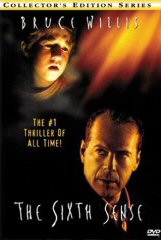
Coming to this film seven years after the fact, my two cents' worth may seem a bit superfluous. However, I saw the film in its single-DVD "Collector's Edition" recently, and I'm a little perplexed about the "blockbuster" status that the film achieved. I suppose it touched people in some emotional way, but it is not very original, especially in light of a film like RINGU that appeared at roughly the same time. A detailed plot summary hardly seems necessary. Briefly, THE SIXTH SENSE is about a psychic child, a little too obviously named Cole Sear (Haley Joel Osment), who is tormented by his ability to see the unaware dead, and his psychologist, Dr. Malcolm Crowe (Bruce Willis), who is himself tormented by an earlier failure that leads him to solving Cole's problem.
"I see dead people, walking around like regular people. They don't know they're dead," Cole confides to Dr. Crowe. Films about the dead who don't realize their condition are scattered through the fantasy/horror film genre and include CARNIVAL OF SOULS (1962), JACOB'S LADDER (1990), and even, to some extent, the comedy BEETLEJUICE (1987). Episodes of THE TWILIGHT ZONE (1959-64) that deal with the subject include "The Hitch-Hiker," "Judgment Night," "A Passage for Trumpet," "The Passersby," and "Come Wander With Me." Films about prescient children, especially little boys, are almost too numerous to mention, constituting an entire sub-genre of their own. What may be new in THE SIXTH SENSE is the combination of the two elements and a clinical approach to a resolution, bonding the psychologist and his disturbed young patient.
The strong points of the film are the acting of Haley Joel Osment, multi-dimensional and gripping way beyond his eleven years, as well as carefully prepared performances by Toni Collette as Cole's mother and Olivia Williams as Malcolm's wife. Also turning in a chilling performance is Donnie Wahlberg. M. Night Shyamalan's direction and screenplay are thoughtful and atmospheric if not especially original; and since this debut, he has shown that it was, in fact, his *only* idea, subsequently recycled atrociously through a number of wretched, stale films, making one wonder how he continues to receive funding. James Newton Howard's score augments the mood and emotion. The weak link for this viewer is the film's star, Bruce Willis--and I use the word "star" very deliberately. Although Willis brings more restraint to THE SIXTH SENSE than elsewhere, and it is certainly his best work--doubtless because the low-budget project appealed to him so strongly--he is still unmistakably "Bruce Willis the star"; his security services are even billed in the credits! There is no sense of specificity in his performance; the stiffness of his persona overwhelms the character, a sharp contrast with the astonishingly flexible range of young Osment's work or the detail of the principal women's contributions. I must note here that Woody Allen has a little fun with Osment in his 2002 film HOLLYWOOD ENDING where, as an aside, a producer instructs her assistant to send congratulations to Haley Joel Osment for "his lifetime achievement award."
Although at this distance, it's hard to understand the tremendous impact of THE SIXTH SENSE upon initial release, it is, nevertheless, a good genre film, and better than most American commercial cinema fare at the time. It was issued twice in the DVD format by Buena Vista Video: first in the more common single-disc "Collector's Edition Series" to which I refer, and later as a two-disc set in the "Vista Series" with redundant extra documentaries, now discontinued. The DVD presents the film in an anamorphic 1.85:1 widescreen aspect ratio. I note that among the many features, we see three trailers for the film, all of which are not only presented in 1.66:1, giving us more information at the top and bottom of the frame, but in which the images are slightly smaller, so more information is provided at the sides as well. By contrast, the feature itself, in 1.85:1 and seeming slightly zoomed, appears rather cramped. The picture also has a certain amount of grain and is a bit deficient in clarity of detail. The director is practically omnipresent during the DVD's special features, so one has to wonder about his optimal framing, image size, and how much influence he had on the DVD transfer.
There are deleted scenes with copious but not very useful commentary, and unctuously presented special features which are really little more than self-congratulation. In one feature, "Rules and Clues," the film makers discuss how they achieved total consistency for people who view the film more than once and know the twist ending: amusingly, there is a very telling detail (the visible breath of Malcolm's sleeping wife near the end) which altogether negates the film makers' claims about their care in a particular area. An annoyance about the DVD itself is that there is no way of bypassing a long string of advertisements to get to the main menu other than by pressing "skip" on the player about seven times. All in all, this may not be a film that one wants to see more than twice: it is impressive the first time, but starts to seem more threadbare with each successive viewing. I would recommend it now that the price has dropped below $10.
Review by Robert E. Seletsky
| Released by Buena Vista Video |
| Region 1 - NTSC |
| Not Rated |
| Extras : |
| see main review |